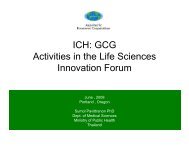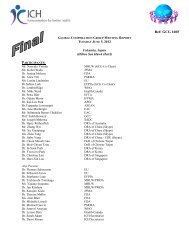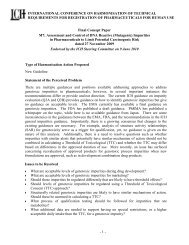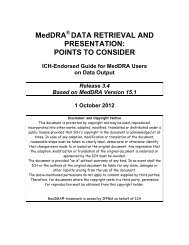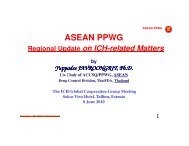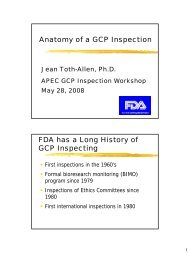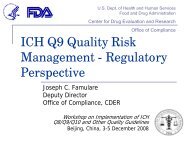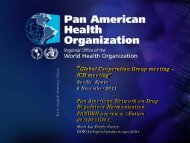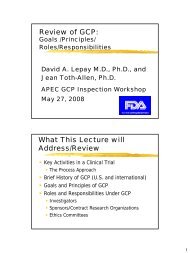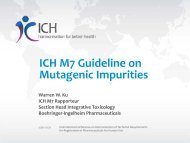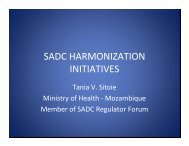ICH Q9 Quality risk management (QRM)
ICH Q9 Quality risk management (QRM)
ICH Q9 Quality risk management (QRM)
You also want an ePaper? Increase the reach of your titles
YUMPU automatically turns print PDFs into web optimized ePapers that Google loves.
<strong>ICH</strong> <strong>Q9</strong><br />
<strong>Quality</strong> <strong>risk</strong> <strong>management</strong> (<strong>QRM</strong>)<br />
Challenges and opportunities<br />
A regulatory perspective<br />
Jacques Morénas<br />
assistant director (Inspectorate and Companies Department)<br />
The French Health Products Safety Agency (AFSSAPS)<br />
Chairman of the PICS<br />
e-mail : jacques.morenas@afssaps.sante.fr
Contents<br />
Introduction<br />
Current European requirements for <strong>risk</strong> assessment/ control<br />
Status and implications of the <strong>ICH</strong> <strong>Q9</strong> guideline<br />
Vision of an ideal world<br />
Conclusion.<br />
2<br />
BIO KOREA 2007 CONFERENCE : Seoul September 2007
Introduction<br />
Expectation 2005<br />
2006<br />
Expectation 2007<br />
<strong>ICH</strong> <strong>Q9</strong><br />
2005<br />
2007<br />
Realization 20..<br />
<strong>ICH</strong> <strong>Q9</strong><br />
2005<br />
20..<br />
<strong>ICH</strong> <strong>Q9</strong><br />
2005<br />
3<br />
BIO KOREA 2007 CONFERENCE : Seoul September 2007
Current European requirements for<br />
<strong>risk</strong> assessment/ control<br />
Risk <strong>management</strong> is not a new concept in EU GMP or EU<br />
approach to assessment of quality dossiers<br />
“Risk” concept mentioned 90 times and in 20 documents in<br />
EU GMP legislation and guidance<br />
Also used frequently in EU (8) [including <strong>ICH</strong> (12) <strong>Quality</strong><br />
guidelines]<br />
In addition “unless otherwise justified” concept frequently<br />
used in both GMP and <strong>Quality</strong> guidelines<br />
4<br />
BIO KOREA 2007 CONFERENCE : Seoul September 2007
Current European requirements for<br />
<strong>risk</strong> assessment/ control<br />
Examples in quality field (guidelines) :<br />
Currently working on a paper<br />
Development Pharmaceutics : annex on sterilisation<br />
<strong>ICH</strong> Q6A: polymorphism (decision tree for identification and<br />
qualification aimed at managing <strong>risk</strong>s ??)<br />
EU Note for guidance on parametric release (requires “ a <strong>risk</strong><br />
analysis of the sterility assurance system”)<br />
EU variations regulations : tries to identify variations/changes<br />
according to degree on <strong>risk</strong><br />
5<br />
BIO KOREA 2007 CONFERENCE : Seoul September 2007
Current European requirements for<br />
<strong>risk</strong> assessment/ control<br />
Examples in quality field<br />
Sterilization : decision tree (aqueous solution)<br />
No<br />
Can the product be sterilized by<br />
moist heat at 121 °C for 15 minutes<br />
Yes<br />
Can the product be sterilized by moist<br />
heat with Fo ≥ 8 minutes achieving SAL<br />
of ≤ 10 -6<br />
No<br />
Yes<br />
Use autoclaving at<br />
121°C for 15 minutes<br />
Can the formulation be filtered<br />
through a microbial retentive filter<br />
Use pre-sterilized individual components<br />
and aseptic compounding and filling<br />
6<br />
No<br />
Yes<br />
Use moist heat<br />
with Fo ≥ 8 minutes<br />
Use a combination of aseptic filtration<br />
and aseptic processing<br />
BIO KOREA 2007 CONFERENCE : Seoul September 2007
Current European requirements for<br />
<strong>risk</strong> assessment/ control<br />
Examples in quality field<br />
Evaluation of :<br />
Impact of proposed changes<br />
Impact of deviations<br />
Impact of “out of specification” results<br />
EMEA Process Analytical Technology (PAT) team involving<br />
assessors and GMP inspectors<br />
7<br />
BIO KOREA 2007 CONFERENCE : Seoul September 2007
Current European requirements for<br />
<strong>risk</strong> assessment/ control<br />
Examples in GMP field<br />
Annex 15 : Qualification and Validation<br />
Scope :<br />
Principles of validation to be applied in manufacture<br />
Manufacturers to identify what validation work is necessary to<br />
control the critical aspects of their operations<br />
“A <strong>risk</strong> assessment approach should be conducted to<br />
determine the scope and extent of validation”<br />
8<br />
BIO KOREA 2007 CONFERENCE : Seoul September 2007
Current European requirements for<br />
<strong>risk</strong> assessment/ control<br />
Examples in GMP field<br />
Routinely used in evaluating quality product defects<br />
EU “Rapid Alert System” classifies regulatory actions based<br />
on relative <strong>risk</strong>s<br />
Grading/evaluation of inspection findings – critical, major,<br />
minor – also based on relative <strong>risk</strong>s<br />
Regulatory decision making on acceptability of manufacturing<br />
sites<br />
Decision by GMP inspectorate as to appropriate resources<br />
needed to be devoted to an inspection<br />
9<br />
BIO KOREA 2007 CONFERENCE : Seoul September 2007
Current European requirements for<br />
<strong>risk</strong> assessment/ control<br />
Examples in GMP field<br />
Inspections in the context of Plasma Master File certificates:<br />
<strong>risk</strong> based approach outlines<br />
Inspections of sites in Non- EU countries - elements of a <strong>risk</strong><br />
based approach<br />
Qualified Person (QP) discretion document in the case of<br />
minor unplanned deviations<br />
10<br />
BIO KOREA 2007 CONFERENCE : Seoul September 2007
Current European requirements for<br />
<strong>risk</strong> assessment/ control<br />
Examples for GMP inspectors<br />
“Inspection staff are expected to have appropriate qualifications,<br />
training, experience and knowledge of the pharmaceutical inspection<br />
process.<br />
They also need to be able to apply an appropriate degree of <strong>risk</strong><br />
assessment.”<br />
Extract from EU <strong>Quality</strong> System framework for GMP inspectorates<br />
11<br />
BIO KOREA 2007 CONFERENCE : Seoul September 2007
Status and implications of the <strong>ICH</strong> <strong>Q9</strong><br />
guideline<br />
Status of <strong>Q9</strong><br />
Adopted in November 2005<br />
Publication by Commission as Annex 20 foreseen<br />
<strong>QRM</strong> implementation groups established at the EMEA level in<br />
GMP and quality guideline area<br />
12<br />
BIO KOREA 2007 CONFERENCE : Seoul September 2007
Status and implications of the <strong>ICH</strong> <strong>Q9</strong><br />
guideline<br />
Implications of <strong>Q9</strong><br />
Impact on some existing GMP guidance documents is under<br />
consideration introducing the concept of <strong>QRM</strong> (i.e. in chapter 1 (part<br />
one) and section 2 (part two) of the EU GMP guide, ….)<br />
Similarly for EU Compilation of Procedures (Guidance for GMP<br />
inspectorates as for training, inspection planning, quality system…)<br />
Training of regulators necessary<br />
Impact on quality guidelines being considered by QWP<br />
13<br />
BIO KOREA 2007 CONFERENCE : Seoul September 2007
Implications of the <strong>QRM</strong><br />
In the submission and assessment process<br />
<strong>QRM</strong> (may be <strong>Q9</strong>) supports presentation of scientific arguments :<br />
For proposals in the submission<br />
For answering subsequent questions and proposals the reviewers<br />
may raise<br />
When linked with “Pharmaceutical development” (<strong>ICH</strong> Q8) it<br />
might avoid the need for such questions by assessors<br />
14<br />
BIO KOREA 2007 CONFERENCE : Seoul September 2007
Implications of the <strong>QRM</strong><br />
In the GMP field<br />
<strong>ICH</strong> <strong>Q9</strong> is not mandatory but <strong>QRM</strong> will be via a modification of<br />
the EU GMP guide. <strong>ICH</strong> <strong>Q9</strong> will be presented as a possible model<br />
(annex 20).<br />
15<br />
BIO KOREA 2007 CONFERENCE : Seoul September 2007
Implications of the <strong>QRM</strong><br />
How can <strong>QRM</strong> activity be inspected ?<br />
If the company explains that <strong>ICH</strong> <strong>Q9</strong> has been used as reference<br />
for establishing the <strong>QRM</strong>, it will be used by inspectors.<br />
If not, inspectors might review :<br />
Whether the quality <strong>risk</strong> <strong>management</strong> performed is<br />
integrated in the <strong>Quality</strong> System of the organization<br />
Traceability, transparency<br />
How was the decision made ?<br />
Was a (<strong>risk</strong>) problem / question defined ?<br />
Did the process performed answer this question ?<br />
Were the appropriate functions allocated to all teams ?<br />
Were the right documents recognized ?<br />
Was the decision based on scientific knowledge ?<br />
16<br />
BIO KOREA 2007 CONFERENCE : Seoul September 2007
Implications of the <strong>QRM</strong><br />
How should <strong>QRM</strong> outcomes be reviewed and inspected ?<br />
Competent authorities should check if the science used for the<br />
quality <strong>risk</strong> <strong>management</strong> process is acceptable<br />
Competent authorities check if the <strong>risk</strong> questions has been<br />
appropriately defined<br />
Competent authorities may not accept the outcome of the <strong>risk</strong><br />
<strong>management</strong> process if it is not satisfactory in terms of science (i.e.<br />
in assessing a quality defect => withdrawal of a product)<br />
Debate and seek agreement on science<br />
17<br />
BIO KOREA 2007 CONFERENCE : Seoul September 2007
Implications of the <strong>QRM</strong><br />
SOP on planning of GMP inspections (reflection)<br />
Inspection frequency and depth should be adapted subject to (and for<br />
example) :<br />
Examination of a site master file (if available)<br />
Review of the products manufactured by the company<br />
Review of the reports from previous inspections<br />
Review of the follow-up actions (if any) arising from previous<br />
inspections<br />
Review of product recalls initiated since the previous inspection<br />
an examination of relevant product defects notified since the<br />
previous inspection<br />
Review of the analysis of any samples analyzed by the Competent<br />
Authority since the previous inspection<br />
Etc …<br />
18<br />
BIO KOREA 2007 CONFERENCE : Seoul September 2007
Implications of the <strong>QRM</strong><br />
SOP on planning of GMP inspections (reflection)<br />
Categories Description Inspection<br />
intervals<br />
Poor compliance<br />
level<br />
The last inspection revealed major or<br />
critical deficiencies ≥ 6<br />
X - 1<br />
Acceptable<br />
compliance level<br />
The two last inspections have revealed no<br />
critical deficiency and less than 6 major<br />
deficiencies 2<br />
X<br />
(= regulatory interval)<br />
Good compliance<br />
level<br />
The two last inspections have revealed no<br />
critical and no major deficiency<br />
X + 1<br />
19<br />
BIO KOREA 2007 CONFERENCE : Seoul September 2007
Implications of the <strong>QRM</strong><br />
SOP on planning of GMP inspections (reflection)<br />
The objectives of Competent Authorities is to optimize the<br />
inspection resources<br />
Review Frequency and depth of inspection based on <strong>QRM</strong> are<br />
still on discussion in a dedicated EWG (France, Germany, Denmark,<br />
Sweden, the UK, the EU Commission and the EMEA)<br />
Using both <strong>QRM</strong> and PQS (Pharmaceutical <strong>Quality</strong> System<br />
which could be <strong>ICH</strong> Q10), confidence between industry and GMP<br />
inspectors should be increased with an impact on inspection<br />
frequency and depth<br />
20<br />
BIO KOREA 2007 CONFERENCE : Seoul September 2007
Vision of an ideal world<br />
An enhanced drug substance and drug product development together<br />
with an implemented <strong>Quality</strong> Risk <strong>management</strong> within the framework<br />
of a Pharmaceutical <strong>Quality</strong> System:<br />
- Risk reduction and better control<br />
- Lower <strong>risk</strong> operations<br />
- Innovation<br />
- Facilitation of continual improvement<br />
- Optimized change <strong>management</strong> proces<br />
May challenge many traditional pharmaceutical approaches<br />
Ultimate aim is to improve the quality of pharmaceuticals delivered to<br />
patients<br />
21<br />
BIO KOREA 2007 CONFERENCE : Seoul September 2007
Conclusion<br />
<strong>Q9</strong> should :<br />
allow an international harmonization of <strong>QRM</strong><br />
facilitate a better comprehension between stakeholders as<br />
QP, regulatory affairs, producers belonging to companies and<br />
assessors, GMP inspectors, the EMEA, the EU Commission,<br />
Heads of Agencies<br />
be used both by industry (with big challenges for small and<br />
medium companies) and Competent Authorities (CA)<br />
allow a better use of resources<br />
increase confidence between industry and CA<br />
22<br />
BIO KOREA 2007 CONFERENCE : Seoul September 2007
Thanks to<br />
Emer Cooke (EMEA)<br />
Jean-Louis Robert (LNS Luxembourg) for their help and<br />
Thanks to you for your attention.<br />
23<br />
BIO KOREA 2007 CONFERENCE : Seoul September 2007




